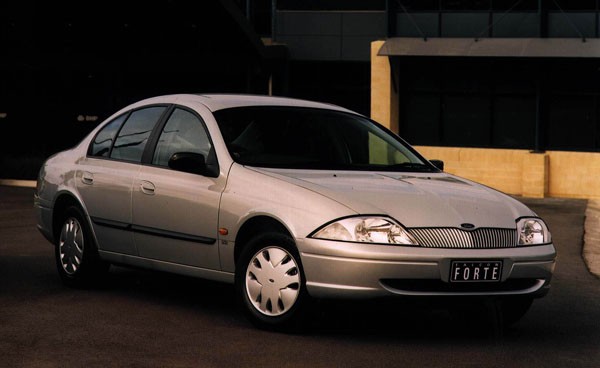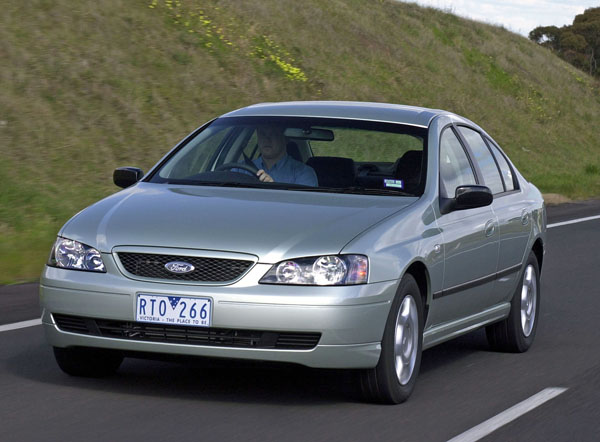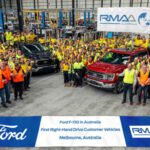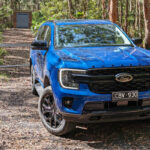Not a lot of new Ford Falcons are sold these days, so there’s a shortage of late models on the used-car scene, but certainly no lack of offering built prior to 2010. For many years Falcon was a huge seller in Australia as the car suits the needs of many local buyers, particularly those in country areas. Built tough for Australia may sound a bit corny, but Falcon certainly answers to that description.
Falcons have seating for five occupants, though four works better if they are all adults because the transmission tunnel takes up a lot of footroom in the centre-rear position. Legroom and headroom are ample for all but the largest adults in the remaining four seats.
Comfort is very good and passengers can step out of a Falcon after a trip of hundreds of kilometres still feeling fresh and relaxed.
The boot in the sedan is relatively shallow, but it’s easy to load thanks to a good-sized opening. From the BA Falcon model onwards things are better, though the boot’s still on the shallow side.
Falcon station wagons are great load carriers as they are built on a longer wheelbase than the sedan so they have a long, wide, practical cargo area. The rear end of the BA is virtually identical to that of the older AU. Ford chose not to do an FG variant of the wagon. Instead, it created a Series III BF model to sell alongside the FG sedans. It wasn’t a success, as SUVs were starting to make inroad in the wagon market, so it was discontinued in 2010.
Handling is surprisingly good for a car of this size and mass. You wouldn’t call it agile, but Falcons hold on when cornering at speeds far above those likely to be attempted by most drivers.
Ford’s six-cylinder engines all have a capacity of 4.0 litres but come in several formats, including one with a turbocharger. An interesting variant on the six-cylinder is a dedicated LPG engine. Very common in taxis, but less so in private cars (except in Victoria) this engine is all but indistinguishable from a petrol unit to drive. The LPG engine is thirstier than the petrol so fuel range suffers.
The BA Falcon’s six-cylinder engine is noticeably smoother and offers even better performance than the units it superseded.
Ford fitted a 5.0-litre V8 to the AU, but it didn’t have a lot more performance than the six-cylinder units and was on the thirsty side. Much better were the BA bent eights. There was a choice of two – both with a capacity of 5.4 litres. One has a single-cam cylinder head, the other a twin-cam setup.
The EcoBoost Falcon has what many say is the best non-V8 engine of them all. It provides excellent performance and nimble handling, due to the lighter weight of the smaller engine.
Buyers in this market segment can be on the conservative side and they stayed away from the EcoBoost in droves, so you can pick up a real bargain as a used-car.
Automatics were all four-speed units until the launch of the BF, when a sophisticated six-speed ZF unit was installed. The ZF was originally only fitted in the topline variants. With the introduction of the FG range all received the six-speed auto, with the exception of the LPG powered models, which held onto the four-speed auto until the launch of the new-design LPG model in July 2011, when it received the six-speed.
Manual gearboxes are rare and probably best avoided in all but the sporting XR6 and XR8 because they can affect resale value. The manual was a five-speed until the BF series, when a six-speed was installed.
Prices for spare parts, servicing and repairs are very reasonable and there are Ford dealers just about everywhere in Australia. Most spare parts for the Falcons covered here are readily available, although a few bits on some older cars may have to come from a wrecker.
These are very simple cars to work on, with plenty of underbonnet and undercar space. We recommend having a workshop manual at your elbow before starting the work.
Insurance prices are generally very reasonable and premiums for the everyday models are invariably at the lower end of the scale. It will generally cost more to cover a V8 Falcon than a straight-six, and more expensive for a turbo six.
WHAT TO LOOK FOR
Many thousands of used Falcons will have been taxis at some time in their life. Be wary of one running on dedicated LPG; while these are quite common in Victoria, they are rare anywhere else in Australia.
Signs of an ex-taxi are vinyl, rather than cloth, upholstery, severe wear both inside and out, holes where signs and a taximeter have been removed, and possibly a paint respray.
Engine wear is indicated by a reluctance to start and smoke from the exhaust and/or the oil filler cap when the engine is revved after it has been idling for more than about a minute.
Four-speed automatics can cause problems on hard-driven cars, especially if they have done a lot of work. Check they change gears cleanly and don’t hunt up and down through the ratios.
Be suspicious of any automatic that’s slow at going into gear from Neutral or Park.
Listen for a whining differential when driving at around 60 to 90km/h.
Check the cabin for damage caused by bored kids. In station wagons have a good look at the load area for signs of commercial use.
Rust is more unusual in these newer Falcons than old ones. If you do find rust the Falcon may have been poorly repaired after a crash.
CAR BUYING TIP
Big old used cars that have been looked after properly and driven correctly can be picked up for pretty low prices these days. Don’t forget to have a professional inspection, though.














